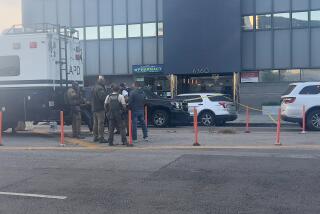Woman shot in D.C. chase is said to have had a fixation on Obama
STAMFORD, Conn. — The woman shot to death after a police chase from the White House to Capitol Hill had been suffering mental health problems, federal law enforcement officials said, including postpartum depression after her daughter was born and a troubling fixation on President Obama.
That portrait began to emerge Friday as police in Washington launched investigations to determine why Miriam Carey, 34, of Stamford, Conn., drove erratically around the White House and Capitol Hill with her 18-month-old daughter in the back seat and whether police responded appropriately by shooting her after she repeatedly refused to stop.
Carey’s declining mental stability, the sources said, developed into a belief that the president was controlling her life, which may explain why she appeared Thursday afternoon next to the White House and then led Secret Service agents and Washington police on a two-mile, three-minute chase down Pennsylvania Avenue. Along the way, two officers were injured.
“She thought that the president had her apartment under surveillance,” said Rep. Michael McCaul (R-Texas), chairman of the House Committee on Homeland Security. “That must have prompted her trip to Washington and her attempt to visit the White House.”
Separately, sources told the Hartford Courant in Connecticut that Carey’s boyfriend had called Stamford police to report concerns about Carey’s mental health and whether her child was at risk.
The sources also said Carey had an obsession with Obama and wanted to meet him. She called herself the “prophet of Stamford,” the sources said.
Carey’s home in Stamford was searched overnight. Scores of police officers and evidence technicians scoured the premises, where she also ran a home-based dental employment agency. Interviews with some who knew Carey suggested she could sometimes be difficult.
Amy Carey, her sister, told CNN, “I just know that my sister did experience postpartum depression with psychosis … which came along with treatment and medication and counseling. It was a momentary breakdown when she had to have emergency care.”
She added that Carey “had her challenges as a new parent” but did not appear to be unstable.
“We will never know what Miriam was thinking in those last hours before she died,” she said. “We can only speculate, and our real concern is why, and were things done properly? Was there some other way that she could have been helped so it didn’t end tragically?”
The Secret Service said it was not aware of Miriam Carey or any fixation with the president. “If she did have these beliefs, the White House would have attracted her,” said one official who asked not to be identified. “It’s like a magnet to a lot of people. The White House is a place that attracts many unstable people.”
Congress was back in session after Thursday’s brief lockdown during the incident. Richard J. Durbin of Illinois, the No. 2 Senate Democrat, said it wasn’t clear what Carey’s motivation was, but he added that Capitol Hill is a “target for those who hate the United States, and someone in a car is a threat.”
Police have not made it clear whether Carey was shot inside or outside her car. Authorities said they were conducting an internal review into the shooting. Law enforcement sources confirmed she was not armed.
McCaul said that the police “didn’t really have much of a choice, given the way she was driving.”
“Plus, the threat to the White House raises the stakes,” he said. “And then this car was seen around the Capitol grounds. That raises the stakes even higher.”
District of Columbia Police Chief Cathy Lanier said Thursday that police handled the incident appropriately.
Courts have said police can use deadly force if a suspect poses a serious risk to them or the public.
William Nathanson, a lawyer whose office is in the same complex as the dental practice where Carey once worked in Hamden, Conn., said for a time she had an annoying practice of parking her car in the sole handicapped parking spot. He noted that Carey had a handicapped parking permit, valid through 2012, yet showed no sign of having difficulty walking or moving.
“I didn’t think it was appropriate,” he said. “We wanted those spaces to be used for patients coming in to see doctors, or for people who were in wheelchairs or couldn’t walk.”
Carey’s family members indicated that they would have a statement about her at some point but first wanted time to grieve privately.
Serrano and Simon reported from Washington, and Susman from Stamford. Alana Semuels and David G. Savage contributed to this report.
More to Read
Start your day right
Sign up for Essential California for news, features and recommendations from the L.A. Times and beyond in your inbox six days a week.
You may occasionally receive promotional content from the Los Angeles Times.









